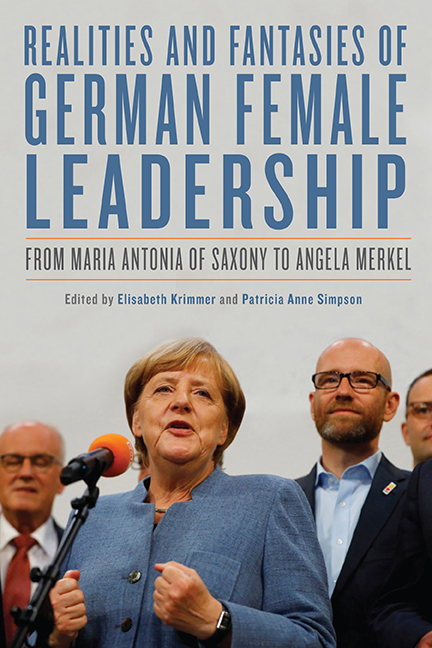Book contents
- Frontmatter
- Contents
- Acknowledgments
- Introduction
- Part I The Age of Enlightened Rule?
- 1 Women's Political Authority in Maria Antonia Walpurgis von Sachsen's Talestris: Königin der Amazonen (Thalestris: Queen of the Amazons, 1763)
- 2 Maxims of Leadership for a Silent Readership: Sophie von La Roche's Pomona für Teutschlands Töchter and Mein Schreibetisch
- 3 Marcus Aurelius, Also for Girls: Discussions on the Best Form of Government in Enlightenment Hamburg
- 4 Dux Femina Facti: Gender, Sovereignty, and (Women's) Literature in Marie Antonia of Saxony's Thalestris and Charlotte von Stein's Dido
- 5 Crossing the Front Lines: Female Leadership, Politics, and War in Die Familie Seldorf
- 6 Power Struggles between Women in Schiller's and Jelinek's Works
- Part II Leadership as Social Activism around 1900
- Part III Women and Political Power in the Twentieth and Twenty-First Centuries
- Bibliography
- Notes on the Contributors
- Index
6 - Power Struggles between Women in Schiller's and Jelinek's Works
from Part I - The Age of Enlightened Rule?
Published online by Cambridge University Press: 24 October 2019
- Frontmatter
- Contents
- Acknowledgments
- Introduction
- Part I The Age of Enlightened Rule?
- 1 Women's Political Authority in Maria Antonia Walpurgis von Sachsen's Talestris: Königin der Amazonen (Thalestris: Queen of the Amazons, 1763)
- 2 Maxims of Leadership for a Silent Readership: Sophie von La Roche's Pomona für Teutschlands Töchter and Mein Schreibetisch
- 3 Marcus Aurelius, Also for Girls: Discussions on the Best Form of Government in Enlightenment Hamburg
- 4 Dux Femina Facti: Gender, Sovereignty, and (Women's) Literature in Marie Antonia of Saxony's Thalestris and Charlotte von Stein's Dido
- 5 Crossing the Front Lines: Female Leadership, Politics, and War in Die Familie Seldorf
- 6 Power Struggles between Women in Schiller's and Jelinek's Works
- Part II Leadership as Social Activism around 1900
- Part III Women and Political Power in the Twentieth and Twenty-First Centuries
- Bibliography
- Notes on the Contributors
- Index
Summary
TO ANYONE READING THE DRAMA Maria Stuart (1800) by Friedrich Schiller today, more than 200 years after its Weimar premiere, the power struggle between the two queens may seem like a dusty tableau from a distant past: on the right in this picture the virginal, austere Elisabeth, queen of England, on the left her seductive and beautiful rival, Maria Stuart, queen of Scotland. And one wonders what motivated Elfriede Jelinek to choose this constellation in her play Ulrike Maria Stuart (2006), which bears the subtitle “Queens’ drama.”
I would like to formulate some theses on this topic that focus primarily on the relationship between women and power. First of all, I will offer a brief analysis of Schiller's “women's drama,” which has received less attention and appreciation in traditional scholarship than his “male dramas” Die Räuber, Don Carlos, Wallenstein or Wilhelm Tell, even though its antithetic structure is considered to be particularly well executed. Moreover, on stage the tragedy of the two competing “sisters” has always stood in the shadow of the Maid of Orleans, which was written a little later and whose “militant femininity” has become an impetus for spectacular new productions, especially in current director-driven theater. Then I will turn to Jelinek's “Secondary Drama,” which, in its reference to the “classical model,” reexamines power and gender conflicts in a contemporary context. As I will show, Schiller ultimately reframes a female competition for power as an erotic rivalry and thus resituates his two female sovereigns safely in a more gender-appropriate sphere. In contrast, Jelinek links female power to maternity and deconstructs the notion that women derive power from motherhood.
Schiller
Schiller began work on Maria Stuart shortly after completing his Wallenstein trilogy. While Wallenstein was about the design of a “genius of strength” (Kraftgenie) who oscillates between grandiosity and depression, 3 Maria Stuart is concerned with the confrontation of two female rulers who fight for power and who—despite many differences—prove similar in character, even though the contrasting arrangement of the drama leads readers to assume the opposite. In some ways, Elisabeth and Maria—much like their “royal sisters” Käthchen von Heilbronn and Penthesilea a little later in Kleist—function as “two sides of the same coin”: together, they represent the “split image of woman” typical of male-authored literature around 1800.
- Type
- Chapter
- Information
- Realities and Fantasies of German Female LeadershipFrom Maria Antonia of Saxony to Angela Merkel, pp. 131 - 144Publisher: Boydell & BrewerPrint publication year: 2019
- 1
- Cited by

